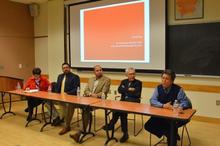Rebuilding Puerto Rico after Hurricane Maria

On February 16, the Council for Latin American and Iberian Studies at the MacMillan Center held a round-table discussion entitled “Rebuilding Puerto Rico after Hurricane Maria.” The discussion brought together four speakers from various disciplines, and approximately 35 audience members, to discuss what happened in the aftermath of Hurricanes Maria and Irma, paying special attention to the political, social, economic, and climatic factors that contributed to the widespread destruction throughout the country. The speakers also discussed how Puerto Rico might move forward after this environmental catastrophe.
The panel was moderated by Priscilla Melendez, Trinity College. Melendez opened the panel with a discussion of what it means to “rebuild” in Puerto Rico. She set the tone for the discussion by emphasizing that rebuilding does not mean a return to what was there before. Puerto Rico cannot, and should not, return to its pre-hurricane state; it must rebuild with an eye towards the future.
Stuart Schwartz, Yale University, contextualized the response to Hurricane Maria by tracing the history of national disaster management in the twentieth century. He explained state-led disaster relief in Cuba following Hurricane Flora in 1963. Then, he contrasted this with U.S. policies in the wake of Hurricane Katrina in 2005, which largely left relief efforts in the hands of local initiatives, charities, and the free market. He argued that the U.S. philosophy on disaster relief continues to be grounded in neoliberal ideologies, which shaped the response to Hurricane Maria in 2017. Overall, by placing Maria in historical context, Schwartz showed that natural disasters are never merely meteorological: they are shaped by geopolitical factors as well.
Next, José G. Caraballo-Cueto, University of Puerto Rico at Cayey, presented his work on the “Exacerbating Effects of Hurricanes on the Puerto Rican Economy.” He began with a thorough overview of Puerto Rico’s pre-Maria economic situation. Before the hurricane, Puerto Rico had already experienced a decade-long period of internal crisis, unemployment, and growing inequality. Within this economic environment, Hurricane Maria had devastating impacts: the economy collapsed, and the percentage of the population living below the poverty line rose to over 50 percent. After explaining the effects of Hurricane Maria, Caraballo-Cueto discussed what must be done to get Puerto Rico back on track. He argued that changes must come from both without and within. The United States must take responsibility for its role in Puerto Rico’s economic troubles and promote economic development; at the same time, Puerto Rico must manage its internal debt and take efforts to mitigate economic inequality.
William Suarez, University of Bradford, UK, was the third speaker on the panel. He spoke about the large-scale impacts of cabotage on Puerto Rico’s agrifood business. Cabotage in this case refers to the laws that restrict commerce between Puerto Rican and mainland American ports. In the wake of Hurricane Maria, these laws had a profound impact on the efficacy of disaster relief; it took nearly a week for the U.S. government to waive laws restricting the transport of relief materials to Puerto Rico. Even before Hurricane Maria, Suarez argued, cabotage was a maze of bureaucratic regulations that complicated the food supply chain. Overall, Suarez showed the complexity of cabotage with respect to the transport and trade of agricultural products and its impact on Puerto Rico’s economy.
Finally, Fernando Abruña, (retired) University of Puerto Rico, spoke about the impacts of Hurricane Maria on the Puerto Rican housing industry and the country’s infrastructure. The major takeaway of his talk was that, in his words, “We [Puerto Rico] created our own vulnerabilities; Maria just brought them to the forefront.” Echoing the sentiments of Melendez, Abruña emphasized that Puerto Rico must do more than just rebuild; it must redesign the entire island, with long-term, environmentally sustainable, resilient solutions. Rebuilding efforts must also necessarily take into account pre-existing inequality on the island and focus on both high-income and low-income communities. Abruña ended his talk with a discussion of some of his LEED Gold certified buildings; these may provide a blueprint for Puerto Rico in its rebuilding process. If Puerto Rico revamps its power grid, energy system, and land use regulations while rebuilding, it may mitigate the impacts of future climatic catastrophes.
The discussion concluded with a lively Q&A session. In general, the questions from the audience were forward-looking in nature: What should be the number-one priority in this period of crisis? What reasonable, short-term goals can be implemented on a local and national scale? And, is there political will among the Puerto Rican government to implement these solutions? The panelists once again emphasized the importance of rebuilding with long-term goals in mind, even as the government works on short-term projects like returning electricity to the island. They also pointed to the importance of local, non-governmental groups (such as churches, schools, and other community organizations) in organizing local rebuilding efforts thus far.
Written by Hannah Greenwald, second-year PhD student.
